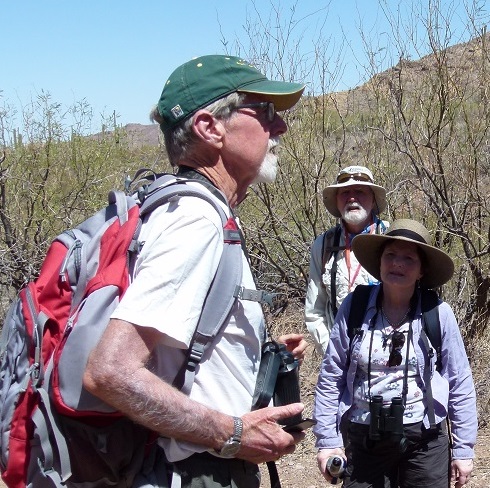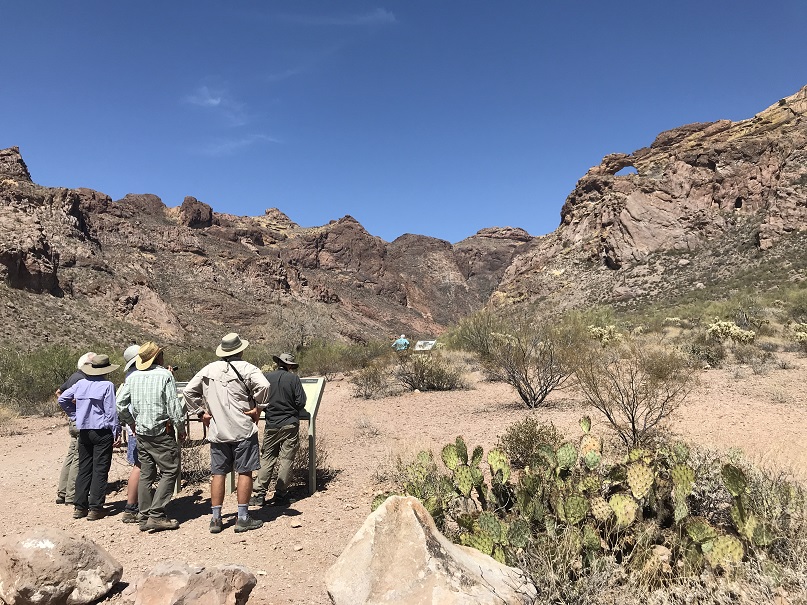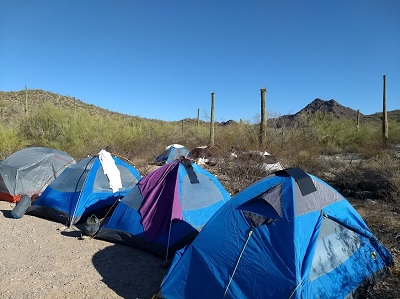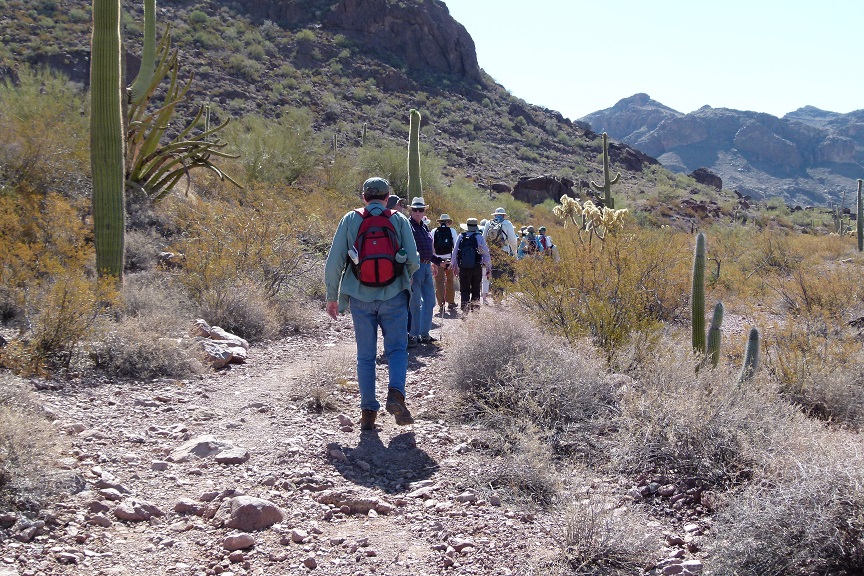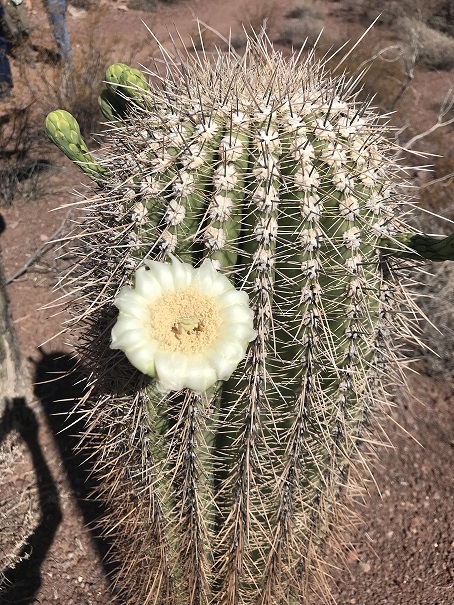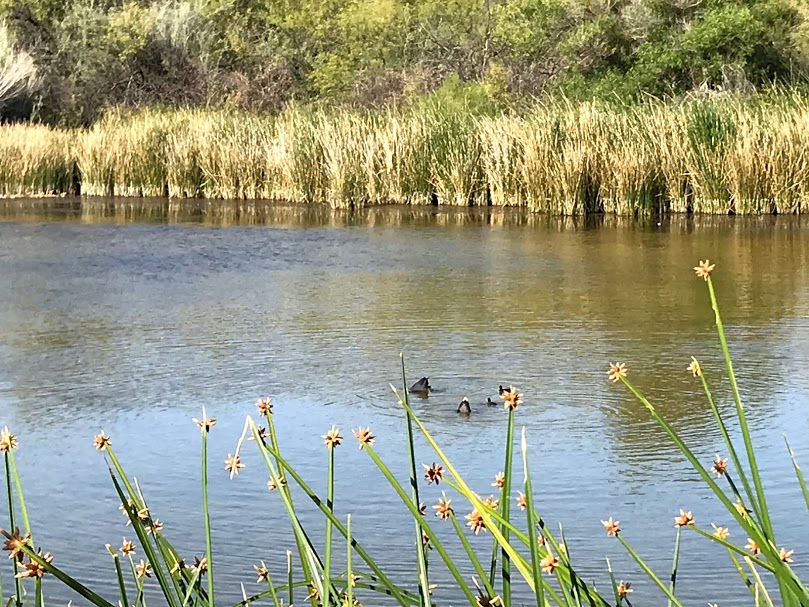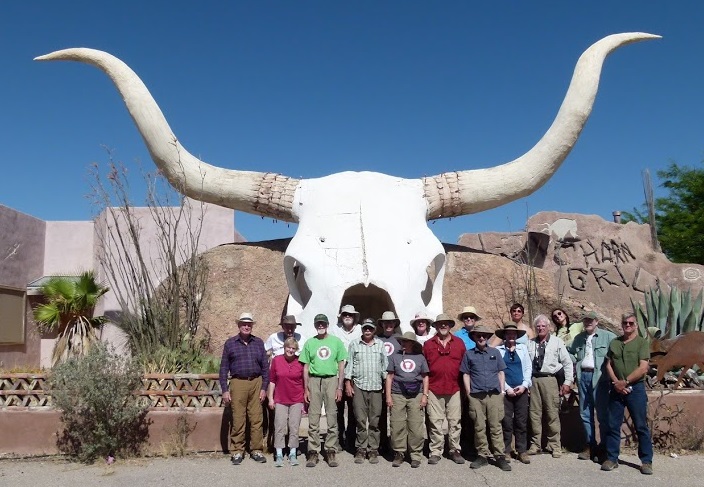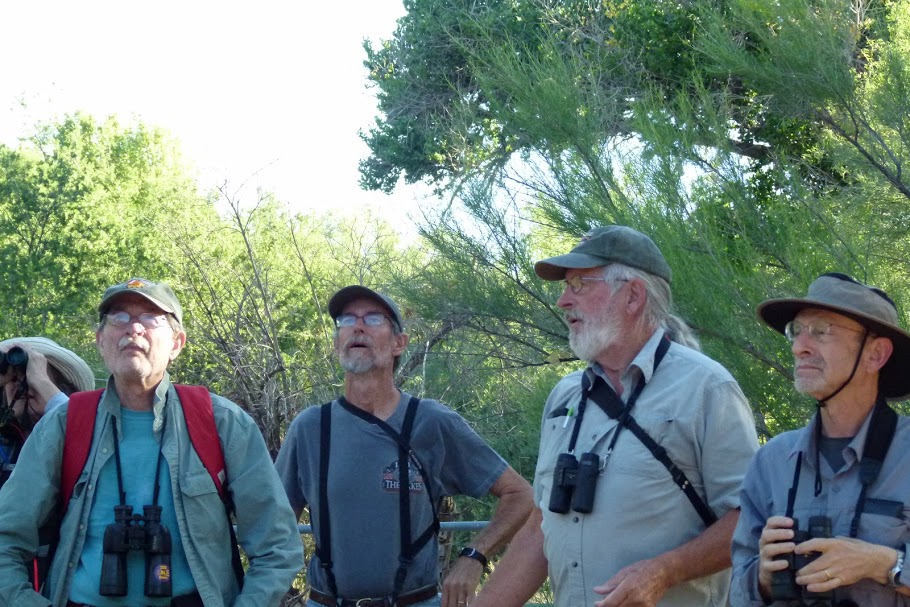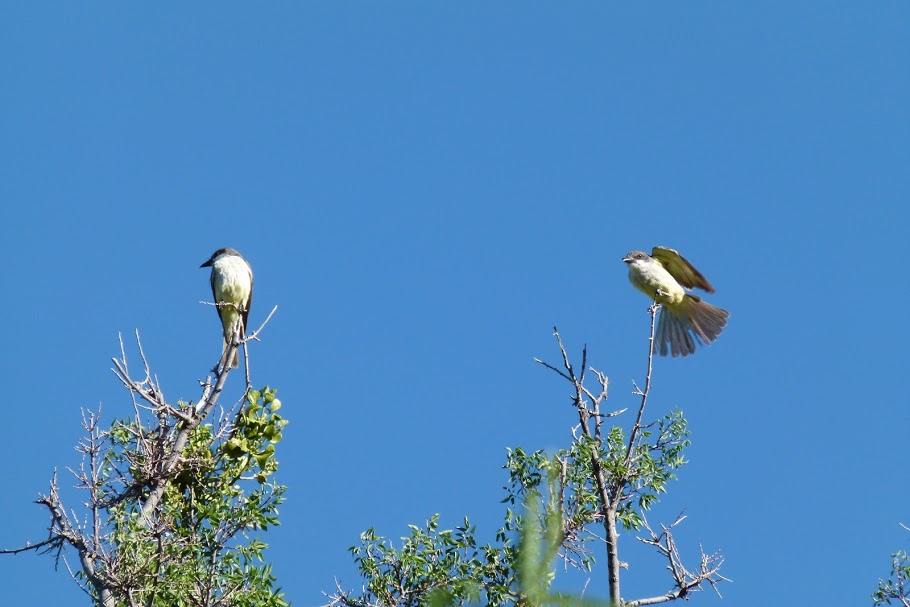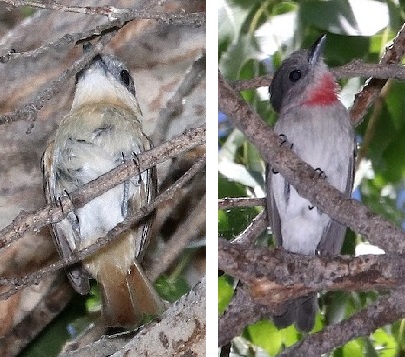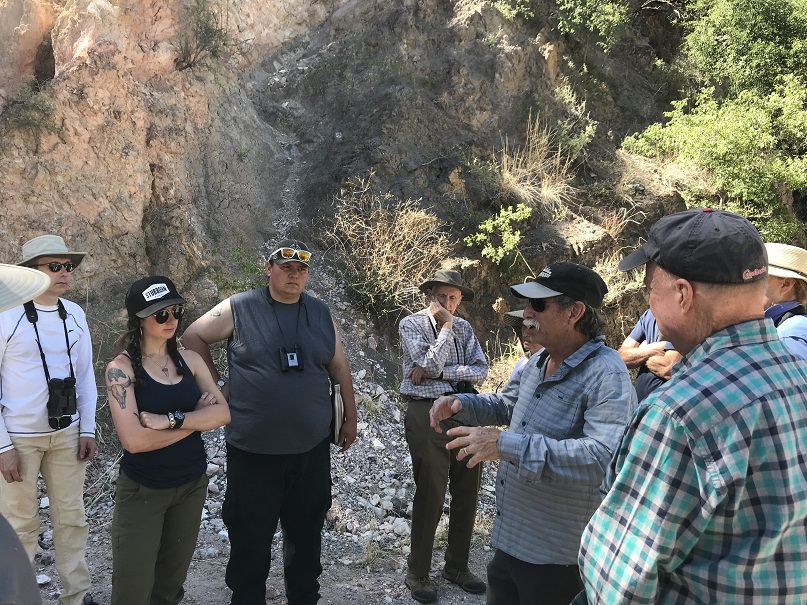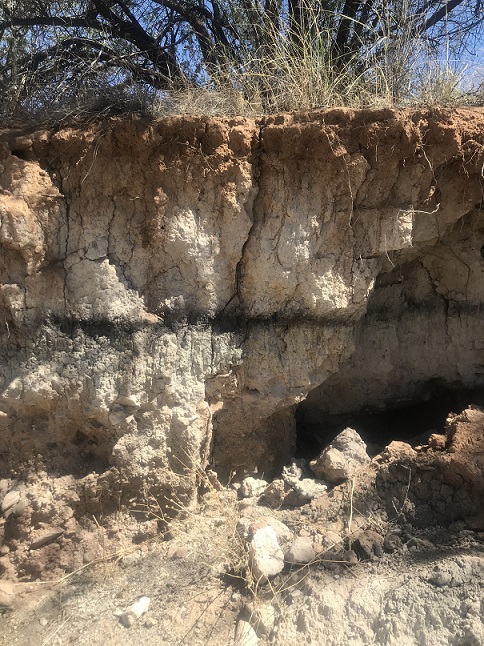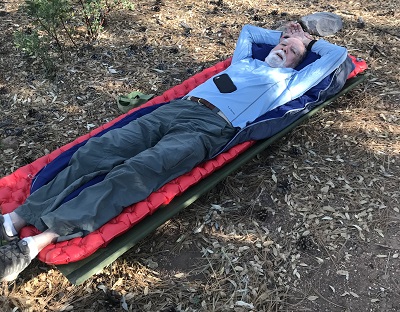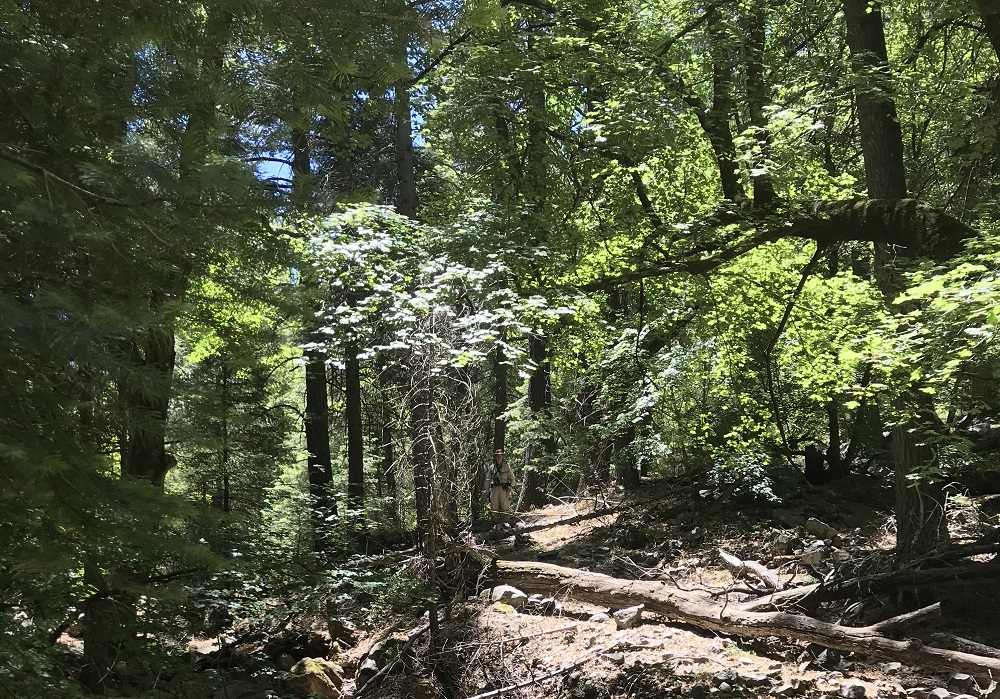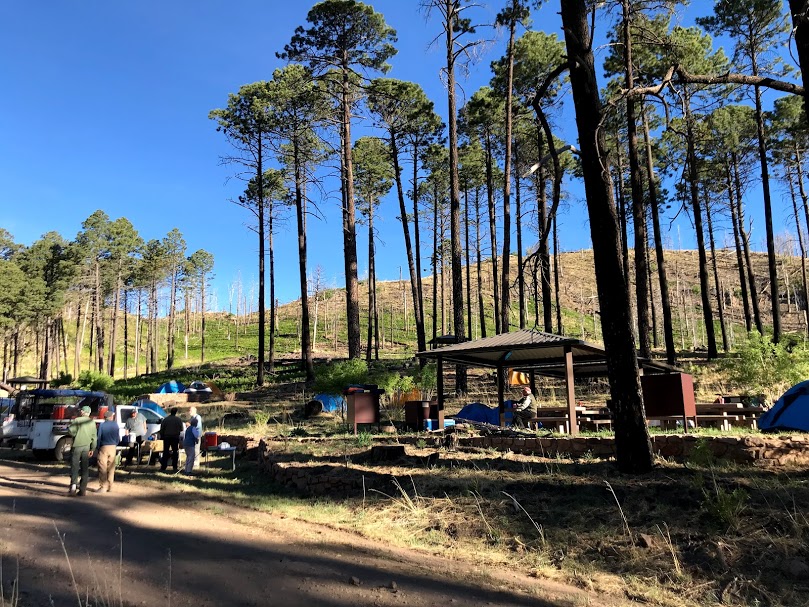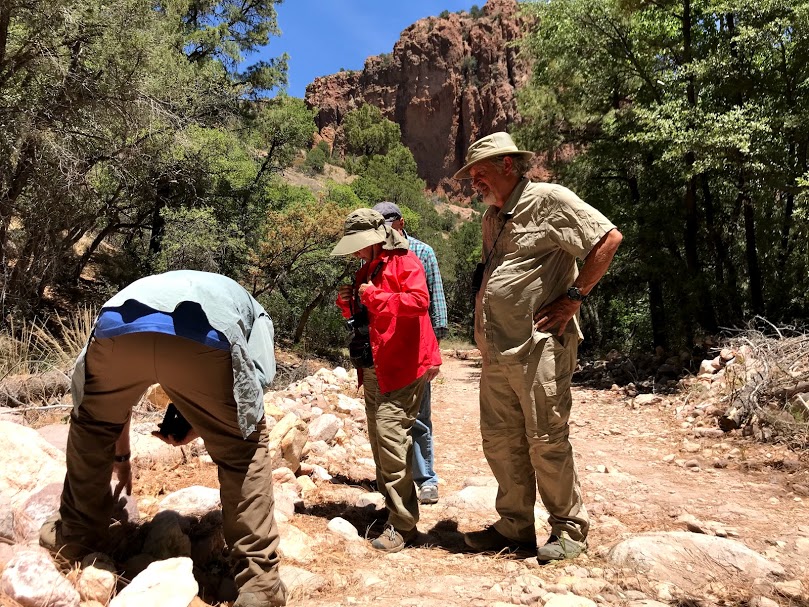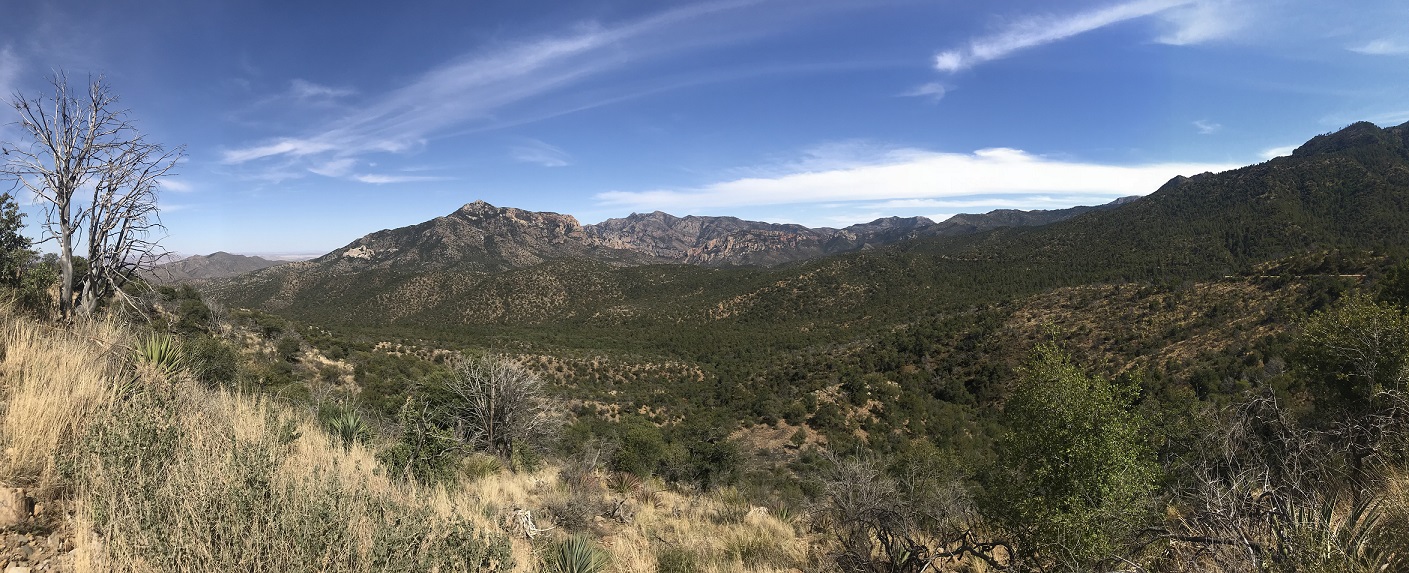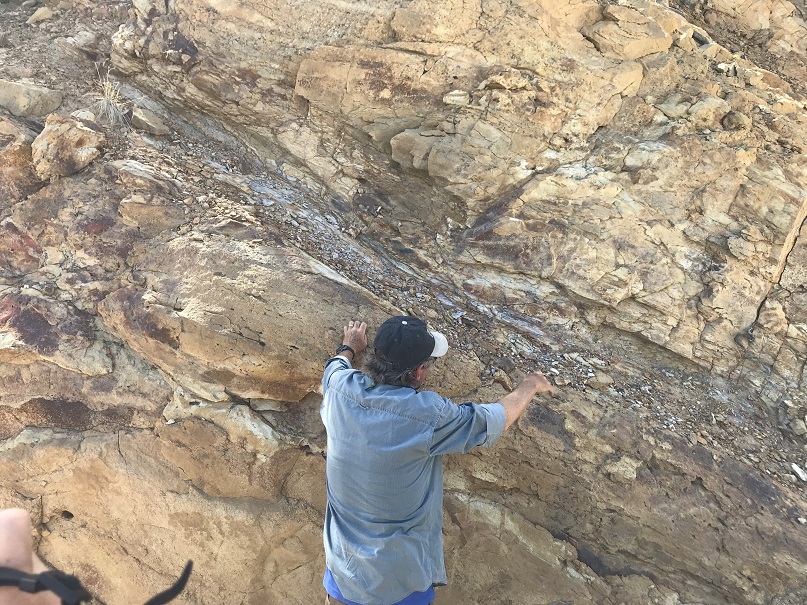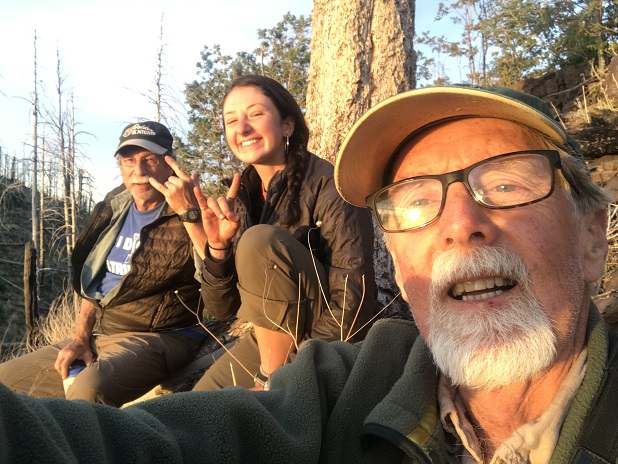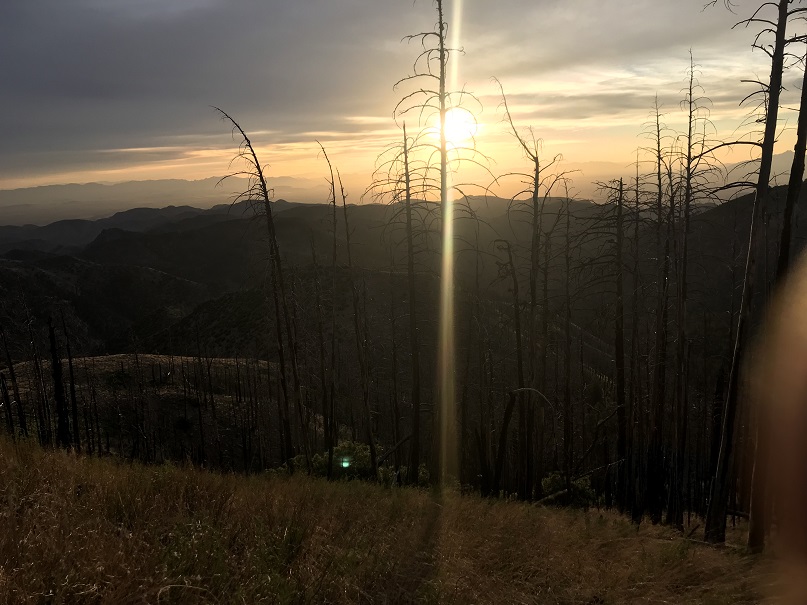|
|
Arch McCallum
It's what we do (among other things). |
Weather: Sunny every day, all day. Lee noted the low temperature every night, and it was always in the 50s, except for the last night, when it dropped to 49. Highs were in the 80s and 90s. Day 1, Saturday, May 19, 2018. Tucson Airport to Organ Pipe Cactus National MonumentTrek participants gathered from near and far. Many were already present in Arizona as of this morning, but five flew into Tucson International Airport between 10 and 2. We assembled in the parking lot in front of this compact airport and had an extended meet and greet as pods of participants arrived. Walter and Becca served an extended lunch of sandwiches and watermelon, and some of us saw the only Greater Roadrunner of the trip. Our caravan was a customized Cottonwood Gulch “com” (commissary truck), plus two rentals, an Armada SUV and a Chevrolet 15-passenger van. We filled the backseat of the van with gear, but this proved unnecessary thereafter, as master-packer Becca soon found a way to fit all the personal duffel into the com along with all of the tents, cots, and kitchen gear. We drove over to the Arizona Sonora Desert Museum for a short introduction to the plants and animals we would visit during our two days in the Sonoran Desert. The Saguaro cactus is of course the icon of this hot desert, and we saw plenty of them, nearly all sporting clumps of their showy white flowers at the summits of their arms. We were there during the heat of the day, but even so were able to see many hummingbirds in the hummingbird aviary and a variety of loud birds in the general aviary. Loudest were a pair of Black-bellied Whistling Ducks, which we have a small chance of seeing in the wild. John Mayer and Richard Stuhr saw a couple of Crested Caracaras outside the fence, but later research revealed that these birds are also a part of the collection, just not on public display. No matter, everyone saw a caracara two days later. A few mammals could be seen in their underground lairs and many fish (yes the desert rivers have a nice assortment of fishes) and reptiles and amphibians were observable in indoor facilities. Speaking of facilities, we were able to freshen up here at the museum before our long drive to Organ Pipe Cactus National Monument. The drive was made longer by having to wait for the Tohono O’odham fire department to put out a small grass fire along the shoulder of the road near Kitt Peak. They did it, and let us pass. As we drove west, we noticed a thick growth of grass along the road shoulders, presumably from ample rains last August. Behind the fences, though, the grass had long since been converted to beef. The trip was made a little longer by a roadside stop, where I hoped to show us a pair of caracaras I had seen three days earlier. No luck there, but we did see Common Ravens and noticed a dry river bed parallel to the road. We also stopped at a gas station in Why, a highway junction just north of the National Monument, where the 2018 FR Trekkers demonstrated for the first of many times their keen appetites for snacks (known to treks past as “belly wash”), regardless of how well fed they are. Of course everyone was on vacation and their parents were not there to look over their shoulders. Becca and Walter had skipped the Desert Museum to get a head start on setting up camp in a group site near the Monument Headquarters. So, when the main caravan arrived around 6 pm, with no more than an hour of daylight left, all was in order. Still, most folks had to get acquainted with their tents and with the new cots. While Walter cooked, Becca helped a number of us figure out the how-to of our new homes, and amazingly it got done rather quickly. An incentive was the hors d’oeuvres and drinks that had already been laid out on one of four picnic tables under the sun shelter, and the ring of 19 comfy camp chairs that awaited. The highlight of the refreshments was a special jar of cider from Kris and Paul, in observance of my gluten prohibition. Boy, was that good! Thus was our routine established. Supper was great. We had a few announcements, and another routine was established. Most of us were sawing logs by nine. (Remember, Arizona is on standard time, so it was dark at 9).
Day 2, Sunday, May 20, 2018. Organ Pipe Cactus National Monument all dayI often try to get up before dawn to catch the dawn chorus. This day I could hear it just fine from my tent, so at 4:43 Common Poorwill, Curve-billed Thrasher, and Ash-throated Flycatcher were singing. By 6:07, according to my eBird app, the desert Big Four (White-winged Dove, Gila Woodpecker, Common Raven, and Cactus Wren) were at it. I guess I was up by then, as was almost everyone. Throughout the trip we tended to be early risers as well as early to bed. The cots, which suspend one about six inches above the ground, and fit snugly into the tents, seemed to get a thumbs up. We noticed two Gila Woodpeckers going in and out of a hole in a Saguaro. They had different amounts of red on the head, so could have been a male and female, except that the books say adult females have no red, so perhaps they were an adult male and a juvenile (all of which have some red). In the latter case, it’s not clear why they kept going into that hole. By 7:47 a couple of Turkey Vultures had cruised by. Southern Arizona is one of the few places in the western U.S. where one can see Black Vultures along with the TVs, and we got several chances to compare the two species later on. Turkey Vultures have lower “wing loading” than Blacks, and so can begin soaring earlier in the day. Wing loading is the amount of weight supported by each square inch of lift-producing surface (wings and tail). Both species use rising columns of warm air (“thermals”) to ascend without flapping, but the greater wing and tail surface of the TV means they can generate more lift and don’t have to wait for the warmer air of mid-morning to get going Vultures and other soaring birds (e.g., hawks, storks) rise without flapping by diving into a rising mass of air. Aerodynamically it’s the same as a seabird that takes off from a cliff and never flaps as it glides for miles and miles before landing on the water. As long as the air is rising faster than the vultures are falling, their bodies rise relative to the earth, even though they are falling relative to the air. Thermals tend to form columns above hot spots in the desert, and so the vulture are often seen rising in a spiral, as they maneuver to stay in the column of rising air. We had a hot breakfast and then packed into the vehicles for the short trip to Alamo Canyon. There is a primitive campground at the trailhead, and we probably could have occupied all four sites without incident, but technically a group of our size is not allowed to camp there. So, we settled for the civilized campground, with its showers. The main attraction at Alamo Canyon is the Ferruginous Pygmy Owl. This is a reliable site for this funny little bird, so common in Latin America, and so rare in the U.S., but 2018 is an off year for the species, with no sightings at all in Arizona. Another headliner for Organ Pipe is the Gilded Flicker, a curious blend of the wing-coloring of the eastern “yellow-shafted flicker” and the facial pattern of the western “red-shafted flicker.” Those two, regarded as separate species back when Ted, Lee, and Ted were on the Prairie Trek, hybridize across a wide swathe from the Rocky Mountains to the eastern forests, producing every degree of intermediate plumage, such as salmon-colored wing-linings. Because it is impossible to draw a line where one ends and the other begins, the taxonomic authorities were forced to “lump” them into one species, dubbed, with little inspiration, the Northern Flicker. The “red-shafted” Northern Flicker lives 100 miles to the east of Organ Pipe, but here in the Sonoran Desert the flickers, known for excavating the cavities used by Elf and Ferruginous Pygmy Owls, are Gilded. It has retained its species status despite the tomfoolery among its cousins. It may have originated from a hybrid population, but if it did selection wiped out the variation: all Gilded Flickers look alike. By the time we hit the trail into Alamo Canyon it was past 9 a.m., not yet hot but already warming up. An old road winds along the edge of the substantial river bed that suggests the mighty erosive power of masses of fast-moving water. The mountains towering to the east have been here long enough that most of the canyon-cutting could have been done in wetter times, when those steep slopes may have been covered with trees. Even so, the channel is probably filled from bank to bank once or twice a year, after one of those violent thunder storms the desert is known for.
We had a pleasant stroll up the canyon. The numerous organ pipe cacti were in bud, but no flowers were seen. Plenty of common desert birds were heard and some were seen. Perhaps the best were our first two Brown-crested Flycatchers, spotted by Ted Chase on the slope above the former “ranch house.” These are the same size and shape as the Great Crested Flycatchers of the east. They look very similar and their sounds are similar enough to suggest kinship. Size, sounds, and the brighter yellow underparts all made clear that they were not the closely-related and slightly smaller Ash-throated Flycatcher, which is common in the desert and above. Unexpected in a desert was a “Western” Flycatcher, out of its nesting habitat here and therefore clearly on migration to some much moister and shadier place. This flycatcher exemplifies the same pattern of variation seen in the Northern Flicker: two distinguishable populations joined by a continuous gradient of intermediates, except that in this case the characters that are distinguishable are vocal. The former Western Flycatcher was split in 1989 into the Pacific-slope and Cordilleran species, a mistake if one wants to be consistent with the handling of the flickers. Birders like to put species names on the WEFLs they see in migration, but it is unwise; many of the birds are intermediate hybrids, so which should you call them? I reported this bird as simply Western. We didn’t find a Ferruginous Pygmy-Owl, or for that matter a Gilded Flicker. The owl was understandable. The problem with the flicker is that it’s common enough that you expect to see it without making a special effort. We didn’t. Also surprisingly scarce was the Black-tailed Gnatcatcher. Luckily John Mayer saved us from missing that one. By the time we got back to camp it was time for lunch, so we ate, and then piled into vehicles for a geology field trip. We had originally considered taking the Puerto Blanco loop, but it is very long on a very rough road, so we opted for the shorter, graded road of Ajo Mountain Drive.. It was a good decision. The geology was spectacular and the scenery enchanting (see banner photograph). The temperature was in the 90s, but we got out of air-conditioned comfort several times to walk around. It wasn’t really bad; dry heat, you know. Along with the white bands on the cliffs, we found some interesting plants. Jojoba and Mormon Tea were growing on the rocky slopes among the more familiar cacti and ocotillo. Jojoba has become well known as a source of skincare products, even though it has not turned out to be the hoped-for source of biofuel that was once predicted. Mormon Tea is also known as Ephedra, which may suggest why it is used to make a tea. Botanically, these weird clusters of sticks are gymnosperms, making them more closely related to pines, cedars, cycads, and ginkgos than any of the plants growing in the desert. Even more “primitive” were the mats of dried plants that looked like a cross between ferns and mosses. They were dormant lycophytes, which plump up and photosynthesize as soon as a rainstorm revivifies them. The geology tour was long, but we had more on the docket. We drove back to camp, picked up a few people who had been relaxing and let off a few who were ready to assume the position in the campfire chairs. Once again we had enough participants to take the van and the SUV. We drove south a few miles on the paved road, then turned west onto a well-maintained gravel road. We were headed for Quitobaquito, an enigmatic oasis hard on the Mexican border. We immediately caught sight of a structure bisecting a small mountain to our left. It was the border “wall.” It was ten or more feet high and was constructed of vertical steel bars that you could see through but couldn’t slip between. Our road went around rather than over the little mountain. On the other side, the formidable wall ended and the border was protected by a one-rail fence. Long bars that looked like the rails trains ride on were mounted about three feet up steel posts that were perhaps ten feet apart. The posts presented an attractive pattern of alternation in height. I imagine these posts were sunk deep into bedrock and that the rails were attached firmly to them. Clearly such a fence would not deter anyone on foot, but driving a vehicle through it may be impossible. It’s a rather cynical approach, as our government’s efforts at interdiction were not sufficient to prevent the hundreds of deaths that resulted from the attempts to walk across the desert. Maybe they planned it that way. Maybe a real wall would be more humane. Just across the fence is Mexico’s Highway 2. It is the main road between mainland Mexico and the ag fields of the Colorado delta, and beyond them the cities of northern Baja California. Consequently it carries a lot of traffic. It is funny to be sitting in a desert wilderness on our side, reading freeway signs just over the border. Beyond the road is a wide valley green with irrigation, and at night the lights reveal that it is home to thousands of people.
Quitobaquito is also green and lush. The parking lot is barren, but a 100-yard walk leads one through luxuriant mesquite trees to a pond fringed by tall tules. Through gaps in the tules we could see American Coots, both adults and their red and black young, swimming about and eating water weeds. The path leads onto a dike, which casts some doubt as to the naturalness of the pond, but no matter. The vegetation shows it has been here a long time. We saw swallows coursing over the water, and spotted a Spotted Sandpiper on the far shoreline. The official bird list said it was rare, but eBird didn’t question us. On the way back we kept seeing ravens. Ted Chase and I saw a pair flying together that seemed extremely small for Common Raven. We had already begun a conversation about the identity of the ravens we were seeing. The Chihuahuan Raven (formerly White-necked Raven) is a bird of desert grassland. Its range is practically the same as the Chihuahuan Desert itself. Common Raven is the raven of everything else, from tundra to Sonoran Desert, where it is common. Predictably, the western edge of the range of the Chihuahuan is the vast grasslands of the Altar Valley southwest of Tucson. But, the two species are hard to tell apart and many identifications may merely affirm the consequent of the ranges of the few correctly identified birds. So, how does one tell the two apart? The Chihuahuan is smaller than the Common (and larger than the American Crow). The bases of Chihuahuan’s neck feathers are white, but this is only visible when the wind blows the feathers up. This happens more often than one would expect, but the same area is gray in Common Raven, and so care is called for. Finally, the voices are somewhat different. My friend Nathan Pieplow has explained the difference and moderated a thoughtful discussion on the overall problem of distinguishing the two species. It is not easy and many mistakes are no doubt made. We don’t need to add to the confusion. It is an error to assume all ravens in Organ Pipe are Common, just as it is an error to misidentify a Common as the unexpected Chihuahuan. Some of you will recognize the first example as Type II error, while the more familiar problem is Type I error. Type II error can be more serious, as when all Ivory-billed Woodpecker sightings are categorically dismissed as misidentifications. What does one do? The right thing to do, although birders are loathe to do it, is to admit you don’t know and back out to the next higher level, “raven sp.” EBird recommends this type of conservatism, and that is what I put down for those two birds. I also noted that they were so small they might be crows, although I concede that two black corvids flying together through the desert are not likely to be crows. But remember, our wilderness park lies right next to a large agricultural area, and crows are attracted to ag like flies to . . . , you know. Now, American Crows come no closer to the Greater Lukeville / Sonoyta area than Tucson and Nogales, but little birding is done in that valley. Finally, there is the possibility of the Sinaloa Crow, which is just as close, at Hermosillo.
Day 3, Monday, May 21, 2018. Organ Pipe Cactus National Monument to Patagonia Lake State ParkThe day began around four for five of us. Last night at the cocktail hour I floated the idea of a pre-breakfast return to Alamo Canyon for one last try for the Ferruginous Pygmy-Owl, which does not occur anywhere on the rest of our itinerary. I promised Walter we would be back for breakfast at 7:30, so we could get on the road by 9:00 for the long drive to Patagonia. John Mayer, Ted Chase, Theresa and Hop signed on. We were in the vans by 4:30 and on the trail by 5:00, right around civil sunrise, although the sun was blocked by the massif of the Ajo Mountains. We replicated yesterday’s walk up the road by the creekbed, even to seeing another (more likely the same) Western Flycatcher. But no owl. And in fact, as of July, the species hasn’t been reported in Arizona once this year. Not to be undone by that disappointment, let me tell you a little about pygmy-owls. Despite weighing only a couple of ounces, pygmy-owls take mostly vertebrate prey, and small birds are frequent food items. They have “converged” on this diurnal small-bird food niche because the hawks and falcons didn’t want it. Who knows if that’s true, but let’s go over what we do know about raptorial birds, ones that hunt vertebrates. They come in three major types, hawks, falcons, and owls. Linnaeus reckoned they were all closely related because they had binocular vision, strong feet with sharp claws, and killed vertebrates, often ones as large as or even larger than themselves (see Harris’s Hawk). Linnaeus didn’t grasp evolution, though, so it’s not too surprising that he didn’t recognize that these similarities were the result of convergence, natural selection fashioning similar solutions to the same problem in different lineages. Owls were recognized as a separate line in the early 1800s, but it wasn’t until this century that the falcons were unequivocally separated from the hawks. When all of us were in school they were two families in the same order, now they are two separate orders, and the falcons are considered most closely related to parrots and songbirds, not hawks and eagles. Back to pygmy-owls, both hawks and falcons seem to bottom out at about the size of our Sharp-shinned Hawk and American Kestrel (a falcon). Sharp-shinned Hawks are superior bird catchers, but they can and do take larger prey than chickadees and sparrows. Enter the pygmy-owls, who have evolved to fill that niche throughout the northern hemisphere and South America. We were back on time for breakfast and the group established a pattern we were to maintain, pulling out before our ETD of 9 a.m. But then we stopped at the visitor center, and people bought stuff, not to mention studying the interesting exhibits, and then we drove up to Why and stopped again, for ice, but most of us needed more coffee, or snacks. Anyway, we had finally settled into the long ride back east when sharp-eyed Theresa calls out “caracara.” Taking a quick glance over my right shoulder, I saw the bird on a fence post at the corner of a settlement and did an immediate about face, pulling onto the should of the north side of the road. The other two vehicles followed suit, and all had good looks at the large black and white raptor with a red beak, before it got tired of the attention and flew off. So, at least one high-interest species was ours. On we went, but when we came to Robles Junction at the top of Altar Valley the prospect of indoor plumbing beckoned. Actually the plumbing was a bit sketchy and the boys were instructed to use the side of the detached bathroom, which judging from the luxuriant vegetation was a common practice. But there was a hardware store here, too, and folks needed to pick up things they forgot. I had been unable to find my miniature hummingbird feeders when packing (mysteriously they continue to hang from the eaves of the house, as they have for months), so Ted Mann stepped up and bought a deluxe model, complete with hummer juice. Ted, it must be noted, had been skeptical when I had said, upon setting up a feeder at a campsite last year, that they would be there in 30 minutes. They were, so maybe Ted was just doing penance for that mistake; but he is a mighty generous guy. We turned south and began slowly ascending the Altar Valley, with thumb-shaped Baboquivari Peak on the ridgeline to our right. Ahead was Buenos Aires National Wildlife Refuge, but with no Masked Bobwhites likely to be found, we took a left after an hour or so and climbed to the town of Arivaca. Surrounded by huge ranches, it should be the old west, but it has a coffee bar and art galleries, so the economy has obviously diversified. The habitat, ideally desert grassland but now converted to mesquite woodland by the cows, is diversified too, as one discovers on the far side of town. There, the Arivaca Cienega is a broad flat valley watered, in most years, by springs. Where usually one finds ducks and herons, we found abundant grass, last year’s crop, swaying in the hot breeze. The boardwalks told us we were traversing a wetland, but they are not needed this year following a winter without rain. But, the Cienega, now part of the refuge, has covered picnic tables, so we sat in comfort listening to the Lucy’s Warblers and watching a male Vermilion Flycatcher as we enjoyed the excellent road lunch. Walter and Becca are happy to make bag lunches when we need them, but they prefer to pull out their gear and make lunch fresh at lunch time. This is a Cottonwood Gulch tradition and it’s a good one to continue on adult treks. We took a stroll through the heat down to the riparian area and saw a variety of birds, the best being a raptor that some thought might be a White-tailed Kite. But it might have been a Gray Hawk, which is more likely here, and we had to let it go as "hawk sp." From Arivaca we wound northeast to Interstate 19, due south toward Nogales, then northeast again to our campsite at Patagonia Lake State Park. It was an uneventful drive, except for the large steer skull we saw when we crossed under the interstate. It was about 20 feet tall, part of the entrance to a boarded up restaurant, and so, because the logo of Cottonwood Gulch is a steer skull, we stopped and took our group picture there.
Right around tea time Alan Schmierer showed up to have a drink and help us plan tomorrow’s activities. Al lived in the Whispering Cedars subdivision, between Thoreau and Gallup, NM, when I was the caretaker at Cottonwood Gulch. I couldn’t have met him before December 1978 and by September 1980 I was visiting him in Minnesota, so I didn’t know him for very long, but we have kept up, sort of, and I didn’t hesitate to ask him for birding advice in this area, his current home base. (Al was an optometrist with the Indian Health Service, and he and his wife managed to move around enough to become local experts in all corners of the country.) So, he informs me that we should go to Tubac and Tumacacori tomorrow and by the way, how early can we be there. I say we can leave here at 6, he says that means you will arrive at 6:45, and we shake on it. I know my group can do it, and besides, no one is required to go. Day 4, Tuesday, May 22, 2018. Patagonia Lake State Park and nearby locations (Tubac and Tumacacori)Everyone went. Walter and Becca know how to handle this sort of thing. Walter was up at like 4 cooking, and they made us a bag breakfast and a bag lunch. Birding requires such early rising that he has come up with an innovation. He lets the coffee steep overnight in cold water, then puts a fire under it first thing, and we have warmed up cold press coffee in a few minutes. By six we were happily coffeed and fed and piled into the vans to retrace the last 45 minutes of yesterday’s ingress. As we followed the back road to I-19 I saw a raven sitting on a power pole. The wind ruffled its neck and I saw white. Or was it gray? Let’s call it white. We have our white-necked raven. Lee saw one, too, somewhere, so even though we might not be sure about every bird, we can be confident we did find at least one Chihuahuan Raven. On the other hand, I recorded a raven call at the lake that, per Pieplow’s protocol, was a Common.
We got to Santa Gertrudis Lane, famous among birders, finding Al and Bill Lisowsky. Al claims not to know this site very well, so he has asked Bill, who knows it better, to lead us. Both Bill and Al could not be more helpful and understanding, and they do know the local birds, as in they can identify every sound they hear. That is the key to efficient birding, a must when there are dozens of unfamiliar birds in this gorgeous lowland riparian area with towering Fremont Cottonwoods. The Santa Cruz River, which flows north out of Mexico and right by Tucson to its rendezvous with the Gila, flows cold and clear here, even if it is only a few inches deep and a few feet wide. Much more water accompanies the surface flow below ground, and waters this incongruous forest surrounded by desert. We began to score within minutes of arriving. No sooner had we passed through the gate from Santa Getrudis Lane, itself only a dirt street, into the de Anza trail than our leaders heard a Thick-billed Kingbird. They showed us both members of a pair, sitting in plain view in the tops of the low trees. If you look at the eBird national rare bird alert for May 22, 2018 you will see Thick-billed Kingbird, based on these sightings. These birds are on territory here, and “everyone” knows about them, so they may make the RBA every day, but they are still among the very few known to be present in the United States.
We had been in this forest for two and a half hours when we returned to the cars and drove a couple of miles north to the Ron Morriss Park, which features a baseball field surrounded by a low chain-link fence. On the fence, as predicted by Bill, were two Tropical Kingbirds. This species also barely gets into the U.S., despite being common from our borders down into South America. RBA again. But this was only a restroom break. Bill didn’t even eBird it. I did, and on that list is also a Swainson’s Hawk that we saw soaring overhead. It’s a handsome little buteo with a brown head and mostly white underparts. The white extends to the wing linings, while the flight feathers are almost black, making for an arresting pattern, and a great field mark. The highlight of the morning was still ahead of us. Year after year a pair of Rose-throated Becards builds a nest above the de Anza trail to our north. In some years they are the only becards known to be in the U.S. That is the situation this year, so if we are to see becards, this is the place.
Becards (“becard” rhymes with “checkered”) are relatives of flycatchers, but uniquely they build an enormous dangling nest of interwoven sticks, leaves, and fibers, well up in the canopy. As we walked the half mile to this year’s location Al and Bill showed us several of the nests from past years. They are still there, but like many other birds, becards don’t reuse old nests, even ones that take a month to build. They were working on the nest when we got there, and we got numerous good views of both the black-capped female and rose-throated male carrying new materials to the burgeoning structure. We were very fortunate to be taken there by folks who know exactly where the nest is. By now we were five hours out from breakfast and folks were eating their lunches as we trudged back to the vehicles. We bid Al and Bill a grateful farewell, but instead of heading home we drove back to Tumacacori to check out the National Historic Site. Scouts were sent in to check it out, they liked it, and John negotiated an entrance fee for those who don’t have Golden Age cards, which get us seniors into most National Parks free. Inside were exhibits, a handsome church, and a shaded fountain in a flowered courtyard. Broad-billed hummers were scooting around, and for a few seconds I watched a cowbird with a hump on the back of his neck, the only Bronzed Cowbird we saw the whole trip. Then it was gone. Then we really did go back to camp, where everyone took a nap. But then Al arrived to show us the shoreline of Patagonia Lake. Half a dozen intrepid souls trooped off on this very worthwhile hike. When I realized we could have driven part of the way I went back for a vehicle, and when I found the group, along a road between the lake and the desert, they were pointing toward the brushy hillside. Al had found a couple of Rufous-winged Sparrows, and everyone got a good look. The juxtaposition of this desert species, here at the northern edge of its extensive range, with Yellow Warblers, which could be heard singing by the lake, is arresting. Yellow warblers are common wherever tree-sized willows are found, which is almost always right beside surface water. The next stop, completely enshrouded by the dense low trees along the lakeshore, had a platform that offered a good look at the shallow upper end of the lake, an impoundment of Sonoita Creek, which flows south toward its junction with the Santa Cruz River. I brought a spotting scope with me to Arizona, and have lugged it around everywhere hoping it will get used. It was absolutely essential here. Ducks, cormorants, and ibises could be made out on the other side, but the scope made it possible to identify them. Most of the cormorants were the Neotropic species. They and the White-faced Ibises were among the least probable birds on our pre-trip list. (Even lower was the becard, as it was not even on our list of possible birds.) We followed the designated birding trail through the woodland, encountering a very large but docile bull among the beef cows, and saw a good variety of birds, as well as a turtle laying a clutch of eggs. A good view of the often-heard but seldom seen Lucy’s Warbler was perhaps the high point. Day 5, Wednesday, May 23, 2018. Patagonia Lake State Park to Reef Town Site CampgroundWe got to sleep later than yesterday, but still managed to break camp efficiently and be on our way by 8:30. The first stop was a mere seven miles up the road at the world’s most famous roadside rest area. Just across the road from storied Sonoita Creek, it was the best place in the U.S. to see Rose-throated Becard and Varied Bunting for generations. The buntings, males of which feature a mélange of blue, magenta, and red, are still there, as are Thick-billed Kingbirds and many other local specialties. No sooner had we gotten out of the vehicle than someone spotted a large flycatcher in full view at the top of the dry slope to the right. After a bit of squinting we realized it was a Thick-billed Kingbird. Soon we heard a second one in the tall trees by the roadside, so apparently we had our second pair in two days.
This is not your everyday rest stop. When the highway department was improving Arizona 82 decades ago, they smoothed the curve right here, leaving a stretch of the old paved road intact, separated from the new road by lower ground. Into this trough they put a single picnic table. The trough is now full of large cottonwoods, replicating the streamside vegetation across the newer road. We worked our way along the old pavement, getting our first excellent views of Phainopeplas. When I found a cluster of 4-5 folks peering through their binoculars at a hummingbird perched on a dead cottonwood branch I innocently advised that it didn’t have to be a Broad-billed, which is the most common hummer in these parts. While others watched, I consulted my Sibley app for other possibilities and made the mistake of calling out that Berylline has rufous wings and tail. That distinguishes it easily from Broad-billed, which has blackish wings and tail. I should have said to the others, “tell me the color of the wings and tail.” Then they wouldn’t have been led, as Perry Mason would lead a jury, toward a conclusion that was not objective. The sequence in which the clues were gathered is not clear, but we (I?) eventually concluded it was a Berylline and not a Broad-billed. I saw red on the bill and a white spot behind the eye. This was consistent with the Sibley app, but most photographs show little red or white. The bird was sitting with his back to us, but in shade. I got a good luck at the wings and I would say they were dull brown, not glossy blue black. Ted Chase saw them as black, but Betsy wrote, on June 5, that it was “about the size of a broad tail with very iridescent green head and neck. The wings and back were very reddish brown.” That is the best evidence we have that it was a Berylline. Right after the bird flew off, Suzanne told me emphatically that the tail was not notched. Primarily on the basis of Suzanne’s and Betsy’s contributions, I do think it was a Berylline, but apparently the powers that be are not convinced. If you do a search for the species on eBird, our record does not come up, meaning it was not accepted by eBird. But it did go out on the eBird Rare Bird Alert, because I got a note of congratulations from a friend in Arizona. Unfortunately no one else found it and confirmed our identification. I concur that our supporting details are too sketchy to justify acceptance by the state records committee, but I think we are justified in keeping it on our trip list. I have updated the eBird list with Betsy’s testimony, but I don’t know if they ever revisit a decision to reject a record. The excitement at the Roadside Rest wasn’t over. As we were walking back to the vehicles two small birds darted past us at eye level, one in hot pursuit of the other. They disappeared in some dense foliage between the old road and the slope. Theresa saw red, blue, and purple on one as it flew by, and that can only mean one thing: Varied Bunting. It is another of those Mexican species that is rare and local in southeastern Arizona. This spot is one of the best places in the U.S. to find it. We next drove a couple of miles into Patagonia, to the Paton Center for Hummingbirds. The Patons were birders who attracted many species of hummingbirds with their feeders. They couldn’t bear to keep other birders out, so their yard became a public place. Since their passing, Tucson Audubon has kept this institution going. The first attraction was actually the White-winged Doves and Gambel’s Quails. Everyone got good looks at them as they foraged for seeds on the ground. A brilliant red adult male Summer Tanager put on a show at a feeder beyond the house. Activity at the hummingbird feeders was slow but steady. Most importantly, we got good looks at Paton’s main attraction, the Violet-eared Hummingbird. This is not the only place, but it is the easiest place to see it in the U.S., and one sat in plain view in a low tree long enough for some good looks. Just down Blue Heaven Road is the storied Patagonia-Sonoita Preserve. It is closed on Tuesdays, so we were unable to visit. It has a wonderful collection of birds, but none we did not see or hear along the Santa Cruz and at the Roadside Rest. We stopped by the Patagonia Post Office to drop off mail and then headed north. The steady climb tops out at the town of Sonoita, which sits at the southwest corner of a large expanse of grassland. We drove through it, and past the numerous sparrows that are there, but silent and invisible at this time of day and year. Within an hour we arrived at the Fry’s supermarket on the eastern edge of Sierra Vista, the largest town in Cochise Country. An extensive shopping trip ensued, with Walter and Becca handling the food and various committees handling the beverages. It must have been over 90 as we ate lunch in the parking lot, and the watermelon was refreshing.
Midday heat is unavoidable, so we braved it for our next stop, the Murray Springs Clovis Site. It is barely ten minutes from the supermarket, but hard to find. Apple doesn’t know where it is, but Google does. Even so, the two-rut track into the site is unmarked and easy to miss. But, after driving half a mile through the desert one comes to a well-maintained parking lot, with a large restroom structure. The site is part of BLM’s San Pedro RNCA (Riparian National Conservation Area), and it has a self-guiding tour. Most of us took the wrong fork, though, and so didn’t see the “black mat,” visible as a thin, dark, horizontal line on the side of the arroyo. Below this contour, dated at 12900 years before the present, are Clovis spear points and mammoth bones galore, above it are the Younger Dryas cold snap, no Clovis artifacts, and no mammoth bones. One hypothesis, as yet unaccepted by the majority of geologists, is that an extra-terrestrial impact caused the deposition of the black mats, and that the ensuing change in climate resulted in the extinction of the megafauna and their hunters, the Clovis people. The mass extinction and the unusual geological layer bring to mind the extinction of the dinosaurs and the deposition of iridium when a comet struck the earth 66 million years ago. Geologists doubted that one too, until the impact crater was found. No impact crater has been found that coincides with the black mats, but a clever way out of that dilemma is the idea that the extra-terrestrial object hit the continental glacier covering the northern US and Canada at the time. The amount of water introduced into the atmosphere by such an impact could have absorbed and reflected enough solar energy to initiate a nuclear winter-style climate shift, while chunks of ice thrown up by the impact could have followed a ballistic path all the way to Nebraska and the southeastern coastal plain, explaining the origin of the enigmatic Carolina Bays. The Younger Dryas Impact Hypothesis would replace the “Pleistocene overkill” hypothesis of Paul Martin, whereby the Clovis people killed all the megafauna. That one replaced the idea that less dramatic climate change is responsible for the demise of the mammoths. Time will tell. YDIH is a great story, but it is a young idea, and it gets short shrift from the elders. In time everyone wandered back to the vehicles and we headed for the highlands. A short drive through the desert took us to Carr Canyon, one of several deep incisions into the flank of the Huachuca Mountains. Then we ascended the steep one-lane road to a fine campground at the Reef Town Site. This was a mining town at the turn of the 19th century. Imagine the men who strung the telephone line up this slope and the women who survived in that grisly mining camp. The weather was perfect up there, at 7200 feet, and everybody set up their tents and cots expertly. Then the hour of fellowship commenced and segued into the hour of feasting and all were pleased.
The tiny Buff-breasted Flycatchers that are here more easily seen than anywhere else in the U.S. “whitted” from the tops of the manzanitas, and Betsy, Theresa, and Suzanne perfectly described an Olive Warbler they had seen. As night fell the Mexican Whip-poor-will did not make its expected appearance, but shortly after dark an owl started calling. I foolishly assumed it was a Whiskered Screech-Owl, because that is the species expected her, instead of an Elf Owl, which we had missed in the desert below. Sooner or later I figured out my mistake. Several of us followed it around for a while but never got a look. It kept calling off and on all night, and was even at it at dawn, when I arose to record whatever flycatchers were present. At least five Buff-breasteds were singing, as was a Dusky-capped on the hilltop to the north, but neither Tufted nor Greater Pewee was present. Also missing was the Eastern Bluebird who sang here a year ago. Day 6, Thursday, May 24, 2018. Reef Town Site Campground to Rustler Park CampgroundThe brilliant part of today’s plan was hiking downhill from the Reef to the Ramsey Canyon Preserve. The mad part was driving to the Chiricahuas after finishing our hike. Even that would not be a terrible idea if we didn’t have to get the vehicles off the mountain. And that was complicated by the importance of having Becca along on the hike to administer first aid if anyone needed it. So, 16 hikers and Walter crammed into the van and drove to the trail head at Ramsey Vista Campground at 9 am, then Walter returned to camp and drove the SUV and the three nonhikers around to Ramsey, where they waited, and waited, and waited for the rest of us. We had nice views of a Greater Pewee and a Black-headed Grosbeak at the outset, and then we were off for Comfort Spring, a seep that has attracted several unexpected species from the south. Not today, though. In fact, we didn’t see a spring, although we did cross a trickle in one of the several small canyons that are the headwaters of Carr Canyon, The trail guide had said we would traverse several of these before crossing into Ramsey Canyon, but it did not mention the long (by our standards) ascent of the final ridge separating the two great gorges. That was not fun. From that watershed it was only a mile or so to the main stem of Ramsey, but that was a long mile. We did begin to see Red-faced Warblers when we reached the timber.
The timber is impressive. Big-tooth Maples, Arizona Cypresses, Montezuma and Ponderosa Pines, Douglasfirs, and Arizona Sycamores are among the trees that shade the permanent stream. They have hosted nesting Eared Quetzals, Tufted Flycatchers, and Flame-colored Tanagers in the past. The latter two are in residence this year, within hailing distance of each other. We stopped at this location for lunch, and I relocated the nest a birder had shown me a few days before. Two or three at a time we sat on the slope and watched the female dart back and forth to the nest, which is snugged up to the trunk on top of a broken off branch, so high above us that the bird was completely unbothered by our presence. The scope got another use here, and came in handy. I had been told that she was going it alone, but two birds were clearly present, making lots of flycatcher noise and darting around in the shady air space below the canopy. The cinnamon-colored birds with triangular crests are certainly among the cutest flycatcher species you will ever see. It would have been nice to see the tanager, too, but the flycatcher was our prize for the day. We continued down the canyon and encountered many birds. The not so Wild Turkeys were the easiest. Everyone but John and I then got to spend plenty of time watching the feeders at the Preserve, but we and Walter were off to climb the reef, drive down, look all over Sierra Vista for a free water hose, and finally ascend to the Ramsey Preserve to pick everyone up. In the late afternoon, we drove down to Bisbee and then up the Sulphur Springs Valley to Pinery Canyon in the Chiricahuas. We saw the charred ground of a fire that had led to the closure of the canyon a couple of weeks earlier, but luckily this was the closest our trip came to being disrupted by forest fires. When we got to Rustler Park we had about fifteen minutes of light for erecting camp. Then Walter cooked a great supper in the dark. He and Becca never complain, they just show up and come through. It’s what they call The Gulch Way. The rest of us sat at the picnic tables under the sun-shelters (the tall pines having been removed by a fire a few years ago), drinking wine and telling stories. In the distance, a whip-poor-will started up at the appropriate time and kept it up most of the night. Day 7, Friday, May 25, 2018. Rustler Park Campground with a visit to Cave Creek Canyon
At 8500 feet, Rustler is quite a bit higher than our highest point in the Huachucas. It wasn’t the predicted 33 degrees at dawn, but it was nice and cool. Rustler was once nestled in an extensive forest of Ponderosa Pine, commingled with Douglasfir, White Fir, and Southwestern White Pine, but today it is mostly bare of trees. The Rattlesnake Fire of 1994 burned 27,500 acres, but did not dip into Rustler. The Horseshoe 2 Fire of 2011, on the other hand, started south of Portal, swept to the crest, and over the other side to the National Monument, consuming 223,000 acres. Patches of living pines dot the burned landscape around the campground, but the place little resembles the dense forest some of us remember from decades ago. The Forest Service closed the campground in 2017 because of damage done to trees by winter storms. They re-opened it this spring, with new bathrooms and sun shelters to replace the shade that was once abundant here. What they mean by “park” in the Chiricahuas is a treeless meadow, too soggy in wet times for tree roots to survive. These are not wet times, precipitation having been unknown on this mountain since last summer’s monsoon. The winter of 99-00 was like that. We wintered in a cabin in Paradise that year and I waited all winter for the first snowfall so I could take my little girls to build a snowman at Rustler. It finally came in March. Despite the drought, enough moisture remains underground to grow a good crop of irises in Rustler’s meadow, and Broad-tailed Hummingbirds zoomed around like spitfires as we climbed out of bed, their primaries screaming. Hummingbirds, like snipe and woodcook, have hit upon the trick of making sexy sounds with their flight feathers. Hummingbird wings might beat 50 times a second, but that is so slow we can barely hear the basso sound it makes. These broad-tails are pealing at 6 kHz, that’s 6000 oscillations, of something, per second. What can possibly vibrate that fast. It turns out to be a specially designed primary feather. Its tip has been narrowed by evolution, leaving a slot between it and the next primary. As the feather rips through the air with each power stroke, the edge of that narrowed feather tip, actuated by the torrent of air rushing through the gap, flaps up and down at a frequency determined by the feather’s stiffness, a frequency in this case of 6000 Hz. This happens with each power stroke, so the sound you actually hear over the meadow is 50 little notes per second, each note at 6000 Hz because the edges of two feathers, one on each wing, are fluttering that fast. Although over a dozen species of hummingbirds can be seen in Arizona with some effort, it seems that each habitat has one main species, one that is most likely if you put a feeder up in a campground. In the Saguaro desert it is the Costa’s, which we saw in Organ Pipe. In the lowland riparian it is the Broad-billed, while here in the high pines it is the Broad-tailed. In the canyons below us it is the Black-chinned. Black-chins, by the way, are essentially identical to the east’s only nesting hummer, the Ruby-throated, except for the color of the male’s throat. Natural selection not having made them different ecologically, they occupy complementary ranges in the east and west, avoiding competition by staying out of each other’s way. It’s sexual selection that has made them into two species. This is a common phenomenon in biogeography. Think Rose-breasted and Black-headed Grosbeak or Indigo and Lazuli Bunting. Speaking of black-chins, we saw plenty of them at the Southwestern Research Station, where the hummer show was dazzling. We had descended from the pines through the dry and birdless oak-juniper woodland to the live oaks and sycamores of Cave Creek Canyon. Where one first meets the creek that makes the sycamores possible one encounters a handsome set of buildings. They were once Cave Creek Ranch, home of author Weldon Heald, who wrote a book called Sky Island (1967) that helped attract me to the Chiricahuas in 1977. By then, Heald had died and his ranch had become the Southwestern Research Station of the American Museum of Natural History. It has been a nexus of ecological field studies ever since. The station welcomes visitors, and in fact lures them in by luring hummingbirds in with a bank of feeders. Here we saw plenty of black-chins and were introduced to the large Rivoli’s and larger Blue-throated species. We also had good looks at a Say’s Phoebe on the fence and great looks at the Acorn Woodpeckers, which also visited the sugar feeders. The Station has established a gift shop with coffee bar, and serving coffee was none other than Barbara Roth, whom I met with her husband Vince, then Director of the Station, in South Fork 41 years ago. They figure into my first encounter with an Eared Quetzal, a misadventure you can read about here.
South Fork is just over a red rhyolite ridge that rises behind the station. We reached it by cruising down the paved road by the main fork, then turning back to the right to enter South Fork. We drove past more devastation, this time caused by flood waters. The road ends well short of the old South Fork Campground, where John Mayer and I spent a couple of nights in 1981. We had promised no more hikes, but those who wanted to did stroll up the former road to the site of the campground. There we heard, as if on cue, the “wonk-wonk-wonk” of the Elegant Trogon. In time he came closer and we all got good views of – get this – the emerald green head, chest, and back above a white band and red belly. Don’t forget the gray wings, yellow bill, and finely lined under-tail. It was hot by now, so we ate lunch in the shade, then drove down to Portal for cold drinks. Portal is an interesting place. Although ranching remains an important part of local culture (mining having petered out a century ago), the village of Portal features retirees of an ecological bent. Some were curators at the AMNH in New York before moving to this naturalist’s nirvana. The programs of the Sew What Club give you an idea of local interests. The Portal store has been a gathering place for generations. Many of us got refreshments and ventured through the kitchen to the bathrooms. Outside were bird feeders and comfortable seats beside the bandstand. But people began to amble up the street to check out the yard feeders that visitors are welcome to watch. One homeowner has made a cutout in his fence and placed in it a bench with a good view of a variety of feeders, where we had good views of Black-headed Grosbeaks and Western Tanagers. Then the owner came out and led us next door to show us a Blue-throated Hummingbird nest on top of a light fixture.
The gravel Trans-Mountain Road is tame compared to Carr Canyon Road, which we ascended in the Huachucas, but the curves are too tight for a semi-trailer. This is seemingly unknown to the occasional trucker who tries to take this route to avoid paying his highway taxes. It would not be a fun place to back down the mountain. We stopped at one of those switchbacks to view the geology of the Chiricahuas. The macro-view on the outside of the switchback is not boring. From our vantage point on the side of the main ridge of the Chiricahuas we looked down on Silver Peak to the left and Portal Peak to the right. Between them runs Cave Creek and its yawning canyon. On the inside of the switchback, we got the micro-level. Geologists love road cuts, and John riffed on this one as though he had known it all his life.
Back on top, most of the crew settled into the afternoon social routine, but the hardcore among us took a quick trip down to Pinery Canyon to look for the Slate-throated Redstart. Pinery, like Rustler above it, has been devastated by fire. Still, one of these birds, whose extensive breeding range extends northward to central Chihuahua, spent last summer here and nested successfully. Most of the many birders who flocked here to see it saw only one adult, and some of the young had incongruous white patches in their wings. It seems likely that a single female colonized the Chiricahuas, secured only the most essential services of a male Painted Redstart (a closely related species that is fairly common in these mountains), and then raised the brood without his assistance. This single-parent of hybrid offspring scenario may be a fairly common component of range expansions, but maybe it is just unsuccessful range expansions. No matter, the same bird, or a dopplegänger, is back this year, in the same place as last year. I had copied descriptions of the exact location of this year’s sightings, most of which mentioned a six-foot waterfall, 2.35 miles down the road from Onion Saddle. At precisely that mileage we saw red flagging tape tied to an oak branch on the roadside. I let the crew of Theresa, John, Ted Chase, and Rick out and found a safe place to park on the steep, winding road. A six-foot waterfall was clearly visible below us, and we scrambled down the steep earthen bank to the edge of a shallow chasm. Somehow all of us made it safely down to the flat limestone shelf across which the small stream ran among yellow columbines and monkeyflowers. It was a beautiful sight even with so few trees around, and must have been serene when it was shaded by fir and pine. Ted felt that we should be exploring the campground rather than the waterfall. Judging from the outcome, he may have been right, but I had the keys so we did it my way. It was hot and still. A Western Wood-Pewee intoned his mournful “pwee,” which is often the only bird sound one hears in the heat of the day. We watched and listened. We walked around a bit. It was so quiet we could have heard the flicking of a redstart’s tail (they do this to startle insects, which they then catch and eat). We heard no such thing, nor did we see our quarry. After a scant twenty minutes we had to return, for supper. We made it up the slope and back to camp in time to be well fed. Before the redstart jaunt Rick asked me about the sunset hike to Barfoot Lookout. I said, “What? Did you read the material I sent out before the trip?” He replied in the affirmative, to my everlasting gratitude. I said, yes, we would do it after supper. I talked this around at camp and others were also interested. But, on the drive back from the redstart search Rick said he would pass on the sunset hike. It’s a hard climb for that spectacular view and I was dreading it, so I wasn’t displeased by Rick’s decision. But I didn’t tell the others who were interested. John (B) made up for my oversight by suggesting that we ascend to the ridgeline visible from our campsite, which a few of us did in time to catch the sunset. It was a much easier hike than Barfoot Lookout, and the view was still stunning. Purple-petaled lupines blanketed the steep slope; standing dead timber reminded us that the lupines were beneficiaries of the fire.
Day 8, Saturday, May 26, 2018. Rustler Park Campground to Kartchner Caverns State ParkA Great Horned Owl visited the camp ‘round midnight, or so I’m told, and Cordilleran Flycatchers sang with the whip-poor-wills and a Wild Turkey at dawn. I was up before dawn recording them. The Mexican Whip-poor-will was belting it out just across the entrance road, near a cabinless chimney, remnant of the only forest service cabin that did not survive the fire. The other cabins, stout buildings that must date from the C.C.C. era, were surrounded by a chorus of Cordillerans. They build their grass and moss nests on ledges, not limbs, and a cabin in the woods usually provides exactly what they want. They are unfazed by people. A town in the firs, such as Cloudcroft, New Mexico, may host two or three pairs per block. We left Rustler without seeing or hearing a Mexican Chickadee. This species, which is common in mountain conifer forests throughout Mexico, is found in the U.S. only in the Chiricahuas and in the Animas Mountains, 30 miles southeast in New Mexico. No chickadee occupies the mountain forests of the Huachucas and the Santa Ritas, and the Mountain Chickadee reaches the southern edge of its range in the Catalinas and Pinaleños, just north of I-10. An ecological paradigm, the “competitive exclusion principle,” holds that if two species require the same resources, the better competitor will cause the other to be absent from the area it occupies. Thus two chickadee species that require the resources available in conifers cannot occur in the same forest, or even mountain range. This is true pretty much everywhere chickadees occur, which is the entire northern hemisphere. We know that the Carolina Chickadee is moving north, and pushing the Black-capped back as it does. We don’t know if the Mexican and Mountain Chickadees are in a stalemate, of if neither has been able to get across the hot and dry, low and wide I-10 desert corridor (which, remember, is the reason Gadsden made his Purchase) to challenge the other. We would like to know, or at least Robert MacArthur thought so. A legendary ecologist of the 1960s, he had his grad student Bob Ricklefs transfer some Mexican Chickadees from the Chiricahuas to Mt. Graham in the Pinalenos, to see how competition would go between them and the resident Mountains. Unfortunately the Mexican Chickadees promptly disappeared and Ricklefs had to find another thesis project. He did, and became a famous ecologist himself. Despite the reduction of its habitat by fire, the Mexican Chickadee is still in the Chiricahuas. We just missed it, perhaps by devoting too much attention to that redstart. We tried again on the way out. We had a date for a cavern tour at 2:30 and John said we could only afford ten minutes standing on the edge of the road above the waterfall, scanning the oaks below for the redstart. No cigar. We then descended Pinery Canyon Road, taking care not to crack any skulls when we went through that mega-dip that surprised the drivers in the waning light two days before. Our first stop was Chiricahua National Monument. The same tuff responsible for the massive cliffs of Cave Creek Canyon is here carved into thousands of free-standing columns. Some of them appear to be boulders balanced on pedestals. We saw some nice birds around the visitor center, including a Scott’s Oriole and a Painted Redstart, then took a little hike up into the rocks on the Natural Bridge Trail.
We then drove up to Willcox for gas and took the short hop on I-10 to the Amerind Institute in Texas Canyon. The huge granite boulders made for a nice picnic spot, because they supported Emory Oak trees that gave us a little shade. Exotic-looking Coral Bean flowers adorned dead-looking stalks emerging from under the rocks. The Institute’s museum is an impressive introduction to southwestern archaeology, and includes artifacts from their signature work on the Casas Grandes culture of northern Chihuahua. Thanks to Debbie Swartz, who visited in the Huachucas, for telling us about this place. Discovered in 1974 by two cavers, Kartchner Caverns, our next and final stop, has been carefully protected from the outset as an Arizona State Park. We took a tour in the afternoon that showed us the world’s longest known soda-straw stalactites and the world’s most extensive formation of brushite moonmilk, among many attractions. Afterward we settled into the best group campsite of the trip. The showers were a bit of a hike, down in the family campground, but the isolation from the RVs was nice. As the camp host said of the RV haven, “this isn’t your scene.” The moon was bright. Walter was visited by a Striped Skunk, and someone saw a Ringtail, a small relative of raccoons whose fluffy tail is as big as its body.
Day 9, Sunday, May 27, 2018. Kartchner Caverns State Park to Tucson AirportI was up before dawn, as usual, recording the exuberant singing of birds at first light. No Black-capped Gnatcatcher was found up the trail into Guindani Canyon. Had it been, we would have worked a gnatcatcher into our last-morning schedule. This very rare (in USA) species was present here in early May, but has not been seen since. I did record the dawnsong of the Northern Beardless Tyrannulet, that hard-to-see vireo-like flycatcher of the south. Check our eBird lists periodically. Sooner or later this recording will be on there. Another exuberant singer was the common Curve-billed Thrasher. Ditto on the recording. Finally, I heard a song that I had briefly heard here on May 19. It was bunting-like, but not a Lazuli. That suggested Varied, which can been seen here. I chased it from the trail to the housing area and across the paved road into the area below our campsite, recording every song but never getting a confirmatory look. Unfortunately, with time it began to sound familiar and finally a look confirmed my suspicion. It was a Blue Grosbeak, an excellent bird, just not a Varied Bunting. One never stops looking for one more new bird, and so the shrubs between Kartchner and Tucson were scanned for Harris’s Hawks. Alas, only the enigmatic raven or two. We gassed up, pulled up to the curb at TUS, and everyone hugged everyone good-bye. It was a great trip. See you next year in Utah.
|
